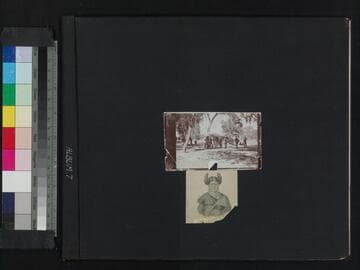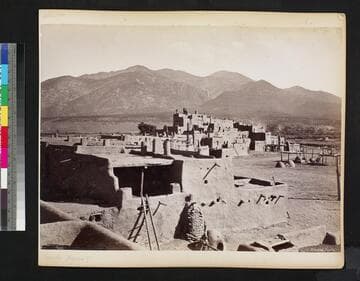Visual Materials
Album of Indians of Southern California and the Southwest
You might also be interested in

Horatio N. Rust Photograph Collection: Album of Indians of Southern California and the Southwest, approximately 1886-approximately 1905
Visual Materials
A photograph album compiled by Horatio Nelson Rust (1828-1906), U.S. Indian agent and archaeological artifact collector, documenting Indians living in Southern California, Arizona and New Mexico, approximately 1886-1905. Includes group portraits of Indian school students in California; members of the Cahuilla, Luiseno, Morongo, Mojave, Hopi, and Navajo tribes; the Indian Council at Pala, 1886; and scenes in Pechanga, Soboba and other native communities of Southern California. A smaller portion of the album includes Southwest and pueblo scenes; archaeological artifacts; and a few commercial photographs of North American Indians from elsewhere.
photCL 7
Image not available
Photographs and Lantern Slides of Artifacts and Indians of California, Southwest and Great Plains
Visual Materials
A collection of photographs and lantern slides compiled by Horatio Nelson Rust (1828-1906), a U.S. Indian agent and artifact collector in California in the late 19th century. The disbound photograph album in Boxes 1 and 2 include many views of Indian artifacts, such as arrowheads, pottery, metal and stone relics, some of which were excavated by Rust himself, as he describes in captions. There are also views of skulls excavated in Missouri, 1879, by Rust. Rust's handwritten captions identifying items and where they were found, by himself or others, are of particular interest in this collection. The album also contains photographs of Indians from Great Plains and western tribes, and Indian schools in Tahlequah, Oklahoma, and Perris, California. There are two striking "before and after" photographs of Chiricahua Apache children sent to Carlisle Indian School, Pennsylvania. Also of note are many views of Southern California Indians, including portraits of Cabazon, Soboba, Luiseno and Cahuilla tribe members, some partially identified by family names: Estudillo; Victoriano of Soboba; Lugo (or Lubo); Casero; Costo; Pablo "Chief of Cahuilla"; Silvestre. Other subjects included: two group portraits of Yuma Indian men, 1891; studio portraits of Keokuk (Sauk); Billy Bowlegs (Seminole); Ouray and Ignacio (Ute); reproductions of drawings of Indians on horses; reproductions of 17th-century deeds related to John Pynchon and colonial Deerfield, Massachusetts; a John K. Hillers photograph of John W. Powell, George W. Ingalls and others in Colorado, 1873; scenes of the Indian Council at Pala, California, 1886; Old Creek Indian Council House, Okmulgee, OK; and portraits of Sam Temple and the Cahuilla woman known as "Ramona," who inspired characters in Helen Hunt Jackson's novel, Ramona. Photographs in Box 3 include views of: Trinity River and vicinity, Northern California, approximately 1880s; camping; scenery; Indian workers standing outside agency; trading post; railroad station in Holbrook, Arizona; missions in California and Tucson, Arizona; Southwest Indians; portrait of Otis T. Mason; archaeological specimens; H. N. Rust family members. Most of the lantern slides in Boxes 4-7 are copies of photographs elsewhere in the Rust Collection, such as: Southwest Pueblo views by John K. Hillers (photCL 10); Rust's trip to Arizona, 1895, with A. C. Vroman (photCL 8). Topics of other slides: Southwest Indians by photographer Frederick H. Maude; San Gabriel Mission; two views of H. N. Rust's home; Aztec artifacts and ruins.
photCL 11

Horatio N. Rust Photograph Collection: Photographic album of Artifacts, and Indians of California, Southwest and Great Plains
Visual Materials
Album which includes many views of Indian artifacts, such as arrowheads, pottery, metal and stone relics, some of which were excavated by Rust himself, as he describes in captions. There are also views of skulls excavated in Missouri, 1879, by Rust. Rust's handwritten captions identifying items and where they were found, by himself or others, are of particular interest in this collection. The album also contains photographs of Indians from Great Plains and western tribes, and Indian schools in Tahlequah, Oklahoma, and Perris, California. There are two striking "before and after" photographs of Chiricahua Apache children sent to Carlisle Indian School, Pennsylvania. Also of note are many views of Southern California Indians, including portraits of Cabazon, Soboba, Luiseno and Cahuilla tribe members, some partially identified by family names: Estudillo; Victoriano of Soboba; Lugo (or Lubo); Casero; Costo; Pablo "Chief of Cahuilla"; Silvestre. Other subjects included: two group portraits of Yuma Indian men, 1891; studio portraits of Keokuk (Sauk); Billy Bowlegs (Seminole); Ouray and Ignacio (Ute); reproductions of drawings of Indians on horses; reproductions of 17th-century deeds related to John Pynchon and colonial Deerfield, Massachusetts; a John K. Hillers photograph of John W. Powell, George W. Ingalls and others in Colorado, 1873; scenes of the Indian Council at Pala, California, 1886; Old Creek Indian Council House, Okmulgee, OK; and portraits of Sam Temple and the Cahuilla woman known as "Ramona," who inspired characters in Helen Hunt Jackson's novel, "Ramona."
photCL 11
Image not available
Photographs of Towns and Indians of the Southwest
Visual Materials
A collection of photographs focusing on Apache and Pueblo Indians and the pueblos of Isleta, Jemez, Taos, Zuni (and dancers), Laguna, and Walpi, ca. 1880s-1890s. There are also early views of Albuquerque and Santa Fe in New Mexico, and Florence and Flagstaff in Arizona; unidentified towns; the Riordan Mansion; Casa Grande ruins (Arizona); cliff-dwellings; and a halfway rest station between Casa Grande and Florence. Mohave, Navajo, Maricopa, Moqui (Hopi), and Pima Indians are also represented. There are some views of digs and human remains unearthed by the Hemenway Southwestern Archaeological Expedition. Includes some photographs by Charles F. Lummis, Isaiah W. Taber, W. Calvin Brown, and a photographer called "Sanders." Images of the Indians include studio portraits and candid field photographs, in particular, Moqui (Hopi) and Zuni Indian dances as well as groups of men on horseback. Other people pictured are Frank Granger Logan, a philanthropist who funded many archaeological expeditions to the Southwest, and D.B. Robinson, an Arizona businessman. Also included is an unidentified newspaper clipping that reports on the Hemenway Southwestern Archaeological Expedition. Research has shown this article to have been published January 1888. Several photos are marked "Sellers" on the reverse, but it is unclear who this refers to. Photographs that have "Sellers" written on their versos are grouped in Folder 5. Copy negatives have been made for photographs (8), (12), (45), (149), and (162).
photCL 215

Photograph album of Southwest Pueblos and portraits of Indian leaders, 1867-1890
Visual Materials
A disbound album of 74 photographs of Hopi pueblos of the Southwest, 1879-1880, and studio portraits of Indian leaders who visited Washington, D.C., on delegation trips, 1867-1890. The majority of individuals photographed are from the Ponca, Yankton Sioux, Navajo and Zuni tribes, with a smaller number of portraits of Apache, Sac & Fox, Ojibwa, and Two Kettle Sioux Indians. The first part of the album contains 26 views of pueblos in New Mexico and Arizona made by photographer John K. Hillers during surveys with the Bureau of Ethnology, Smithsonian Institution, 1879-1880. Almost all are broad scenes of the pueblos and surroundings, with one view of Hopi women in a dance circle at Oraibi and one view of a Navajo hogan. The second section of the album contains 48 studio portraits, including many Ponca Indian leaders listed in William Henry Jackson's "Descriptive Catalogue of Photographs of North American Indians" (1877). Other portraits include Yankton Sioux leaders (1867); Navajo chief Manuelito and his wife and son; We-Wha, a Zuni male transvestite; Zuni governor Pedro Pino; and other notable individuals. Besides Jackson, the portraits were made by photographers Charles M. Bell, Alexander Gardner, John K. Hillers and A. Zeno Shindler.
photCL 190
Image not available
Horatio N. Rust Photograph Collection
Visual Materials
A collection of photographs compiled by Horatio N. Rust (1828-1906), U.S. Indian agent and archaeological artifact collector. The main focus of the collection is Indians of Southern California and the Southwest in the late 19th century, including a set of photographs of Southwest Pueblos by John K. Hillers. There is also a collection of photographs related to abolitionist John Brown and his descendants living in the West. The collection has been divided into five groups: (photCL 7) Album of Indians of Southern California and the Southwest, approximately 1886-1905. A photograph album compiled by Rust, documenting Indians living in Southern California, Arizona and New Mexico, approximately 1886-1905. Includes group portraits of Indian school students in California; members of the Cahuilla, Luiseno, Morongo, Mojave, Hopi, and Navajo tribes; the Indian Council at Pala, 1886; and scenes in Pechanga, Soboba and other native communities of Southern California. (photCL 8) Trip to Arizona, 1895 Photographs made mostly by A. C. Vroman during Rust's 1895 trip from Southern California to Arizona to see the Hopi Snake Dance at Walpi. Rust was accompanied by Mrs. Thaddeus (Leontine) Lowe, Vroman, and Charles J. Crandall. Views include Hopi and Navajo Indians and scenes of pueblo life; the Snake Dance at Walpi; the Grand Canyon; the Petrified Forest; desert landscapes; a group portrait of Mojave Indians at Needles, California; and several views of Rust and his fellow travelers with guides, wagons and supplies. (photCL 9) John Brown Collection, approximately 1850-1897. Photographs, prints and ephemera pertaining to abolitionist John Brown and his family. Includes portraits of Brown, his family members, supporters and other abolitionists; participants in the raid on Harper's Ferry and officials involved in Brown's trial; views of Harper's Ferry and buildings related to the raid; and views of Brown's grave and home in New York. There are also several views of Jason and Owen Brown's Las Casitas homestead in the mountains near Pasadena, California, and a scene of mourners gathered at Owen Brown's grave. A few additional items in the collection were acquired from other sources and transferred to the collection at various times. (photCL 10) U.S. Bureau of Ethnology Expedition Photographs of Southwest Pueblos by John K. Hillers, approximately 1879-1881. Views of pueblo villages and surrounding landscape; some show people and details such as pottery, ovens, and food and water sources. (photCL 11) Photographs and Lantern Slides of Artifacts and Indians of California, Southwest and Great Plains, approximately 1870s-1890s. Views of artifacts, some of which were excavated by Rust himself, as he describes in captions; Indians from Great Plains and western tribes; Indian schools in Tahlequah, Oklahoma, and Perris, California; Southern California Indians. The lantern slides are mostly copies of photographs elsewhere in the Rust Collection, such as: Southwest Pueblo views by John K. Hillers (photCL 10); Rust's trip to Arizona, 1895, with A. C. Vroman (photCL 8). Topics of other slides: Southwest Indians by photographer Frederick H. Maude; San Gabriel Mission; two views of H. N. Rust's home; Aztec artifacts and ruins.
photCL 7-11